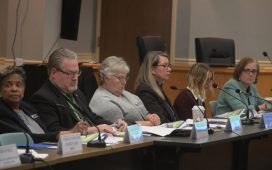||
While wild horses on the nation’s public lands often elicit a romantic image of the West, these quickly growing herds have long faced problems associated with overpopulation. But results of a recent study offer a promising tool to help address those challenges.
Some effects of the situation have been seen this spring in Colorado and other areas. The recent death of more than 140 wild horses due to an equine influenza outbreak at a Bureau of Land Management facility in Cañon City prompted Colorado Gov. Jared Polis to call for further evaluation to prevent a similar situation in the future.
And BLM officials recently launched a $20 million effort to increase the use of fertility control to slow the growth of wild horse and burro herds, which they say has expanded to three times the appropriate size for the public lands on which they live.
Now, a research study released this spring by the U.S. Geological Survey and Colorado State University explores one way to help manage herds humanely.
The USGS collaborated with Sarah King, a research scientist in the Natural Resource Ecology Laboratory at CSU, to test the effects of gelding wild horses in the Conger Herd Management Area in Utah.
Gelding, or castrating, horses is a common practice seen for domesticated horses. The study sought to determine if gelding could reduce population growth and if it changed important social behaviors.
In the study, titled “Effect of adult male sterilization on the behavior and social associations of a feral polygynous ungulate: the horse,” and published in Applied Animal Behaviour Science, King and USGS scientist and CSU Affiliate Kate Schoenecker and NREL Research Associate Mary Cole examined how gelding stallions might affect the behavior and mare retention patterns within the herd.
[Story Continues Below]
“These horses are not native to the United States,” said King, who also serves as an associate faculty member within the Ecosystem Science and Sustainability department at Warner College of Natural Resources. “The populations have increased dramatically over the past 10 to 20 years. More recently, it’s just been an exponential increase, so the Bureau of Land Management is looking for different ways of managing the horses to control population growth.”
Although castration for domesticated animals like cats and dogs, as well as feral animal “catch and release programs” are common practice, studying how gelding affects behavior within these animals’ herd dynamics is an understudied area.
“From an animal behavior aspect, it was really interesting to explore this topic given the lack of literature,” King said. “A major goal was to see if gelding would reduce the population growth of the herd for the sake of land management.”
Exploring Behavioral Ecology And Managing Wild Geldings
The execution of the study involved gathering the population and gelding 27 of the 34 male horses caught. Over the course of four years, King and her colleagues reviewed changes in behavior such as aggression, social group size and the ability for a gelded male to attract and keep mares.
“It was actually really interesting to find that gelding had minimal effects on male behavior,” King said. “It seemed a really positive thing that although the males were castrated, they were continuing to maintain their associations with mares.”
The findings from the study also highlighted the capacity for gelding to be a safe population control tool for wild horse populations. Moving forward, King and colleagues will use the results of this study to explore female behavior, social networks, group changes and resource selection in relation to the movement of wild horse herds.
“Understanding the behavior of animals is often undervalued in how it can be used to manage animals and also to conserve them,” King said. “Once we understand how and why animals are using the landscape, it can really affect management decisions and what will affect fertility and reproductive behavior.”
Read more at Colorado State University.









